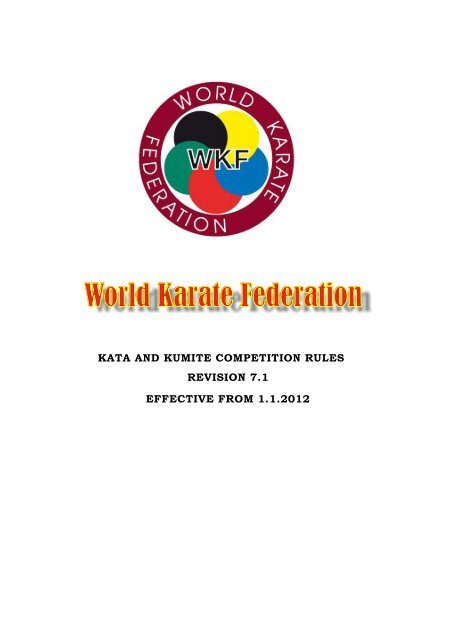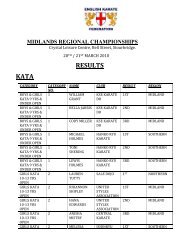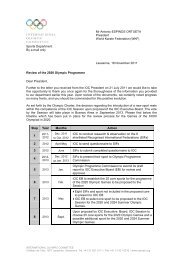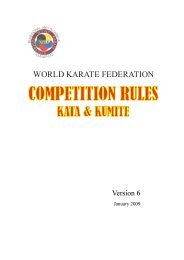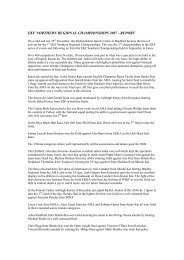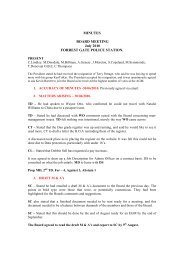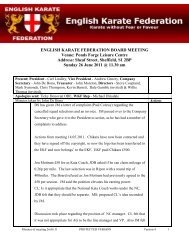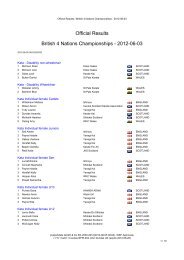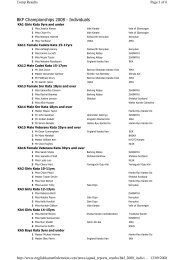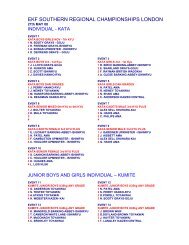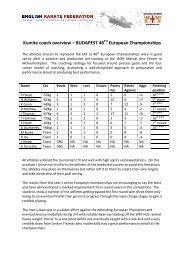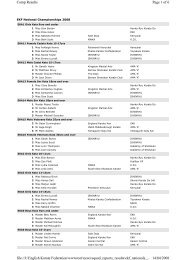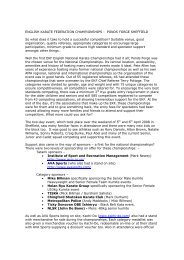WKF Rules Version 7.1.pdf - Karate New Brunswick
WKF Rules Version 7.1.pdf - Karate New Brunswick
WKF Rules Version 7.1.pdf - Karate New Brunswick
You also want an ePaper? Increase the reach of your titles
YUMPU automatically turns print PDFs into web optimized ePapers that Google loves.
2CONTENTSKUMITE RULES 4ARTICLE 1: KUMITE COMPETITION AREA 4ARTICLE 2: OFFICIAL DRESS 5ARTICLE 3: ORGANISATION OF KUMITE COMPETITIONS 7ARTICLE 4: THE JUDGES PANNEL 8ARTICLE 5: DURATION OF BOUT 9ARTICLE 6: SCORING 9ARTICLE 7: CRITERIA FOR DECISION 12ARTICLE 8: PROHIBITED BEHAVIOUR 13ARTICLE 9: WARNINGS & PENALTIES 16ARTICLE 10: INJURIES AND ACCIDENTS IN COMPETITION 17ARTICLE 11: OFFICIAL PROTEST 19ARTICLE 12: POWERS AND DUTIES 21ARTICLE 13: STARTING, SUSPENDING AND ENDING OF MATCHES 23ARTICLE 14: MODIFICATIONS 25KATA RULES 26ARTICLE 1: KATA COMPETITION AREA 26ARTICLE 2: OFFICIAL DRESS 26ARTICLE 3: ORGANISATION OF KATA COMPETITION 26ARTICLE 4: THE JUDGING PANEL 27ARTICLE 5: CRITERIA FOR DECISION 28ARTICLE 6: OPERATION OF MATCHES 29* VERSION 7.1 –Effective from 01.01.2012
3APPENDIX 1: TERMINOLOGY 30APPENDIX 2: GESTURES AND FLAG SIGNALS 32ANNOUNCEMENTS AND GESTURES OF THE REFEREE 32THE JUDGE’S FLAG SIGNALS 39APPENDIX 3: OPERATIONAL GUIDELINES FOR REFEREES AND JUDGES 43APPENDIX 4: SCOREKEEPERS MARKS 46APPENDIX 5: LAYOUT OF THE KUMITE COMPETITION AREA 47APPENDIX 6: LAYOUT OF THE KATA COMPETITION AREA 48APPENDIX 7: THE COPULSORY KATA LIST 49APPENDIX 8: <strong>WKF</strong> TOKUI KATA LIST 50APPENDIX 9: THE KARATE GI 52APPENDIX 10: WORLD CHAMPIONSHIPS CONDITIONS & CATEGORIES 53APPENDIX 11: REFEREES AND JUDGES TROUSERS COLOUR GUIDE 54It should be noted that the male gender used in this text also refers to the female.* VERSION 7.1 –Effective from 01.01.2012
6prohibited, as are metal hairgrips. Ribbons, beads and other decorations are prohibited. A discreetrubber band or pony tail retainer is permitted.7. Contestants must have short fingernails and must not wear metallic or other objects, which mightinjure their opponents. The use of metallic teeth braces must be approved by the Referee and theOfficial Doctor. The contestant accepts full responsibility for any injury.8. The following protective equipment is compulsory:8.1 <strong>WKF</strong> approved mitts, one contestant wearing red and the other wearing blue.8.2. Gum shield.8.3. <strong>WKF</strong> approved body protection (for all athletes) plus chest protector for female athletes.8.4. The shin pads approved by the <strong>WKF</strong>, one contestant wearing red and the other wearing blue.8.5. The foot protection approved by the <strong>WKF</strong>, one contestant wearing red and the other wearingblue.8.6. Cadets will, in addition to the above, also wear the <strong>WKF</strong> approved face mask.Groin Guards are not mandatory but if worn must be of approved <strong>WKF</strong> type.9. Glasses are forbidden. Soft contact lenses can be worn at the contestant's own risk.10. The wearing of unauthorised apparel, clothing or equipment is forbidden.11. All protective equipment must be <strong>WKF</strong> homologated.12. It is the duty of the Match Supervisor (Kansa) to ensure before each match or bout that thecompetitors are wearing the approved equipment. (In the case of Continental Union, International,or National Federation Championships it should be noted that <strong>WKF</strong> approved equipment, must beaccepted and cannot be refused).13. The use of bandages, padding, or supports because of injury must be approved by the Referee onthe advice of the Tournament Doctor.COACHES1. Coaches shall at all times during the tournament, wear the official tracksuit of their NationalFederation and display their official identification.EXPLANATION:I. The contestant must wear a single belt. This will be red for AKA and blue for AO. Belts ofgrade should not be worn during the bout.II.III.IV.Gum shields must fit properly.If a contestant comes into the area inappropriately dressed, he or she will not be immediatelydisqualified; instead they will be given one minute to remedy matters.If the Referee Commission agrees, Refereeing Officials may be allowed to remove theirblazers.* VERSION 7.1 – Effective from 01.01.2012
7ARTICLE 3:ORGANISATION OF KUMITE COMPETITIONS1. A <strong>Karate</strong> tournament may comprise Kumite competition and/or Kata competition. The Kumitecompetition may be further divided into the team match and the individual match. The individualmatch may be further divided into age and weight divisions. Weight divisions are dividedultimately into bouts. The term ―bout‖ also describes the individual Kumite competitions betweenopposing pairs of team members.2. No contestant may be replaced by another in an individual title match.3. Individual contestants or teams that do not present themselves when called will be disqualified(KIKEN) from that category. In team matches the score for the bout not taking place will then beset to 8-0 in favour of the other team.4. Male teams comprise seven members with five competing in a round. Female teams comprisefour members with three competing in a round.5. The contestants are all members of the team. There are no fixed reserves.6. Before each match, a team representative must hand into the official table, an official formdefining the names and fighting order of the competing team members. The participants drawnfrom the full team of seven, or four members, and their fighting order, can be changed for eachround provided the new fighting order is notified first, but once notified, it cannot then bechanged until that round is completed.7. A team will be disqualified if any of its members or its coach changes the team's composition orfighting order without written notification prior to the round.8. In team matches where an individual looses on account of receiving Hansoku or Shikkaku, anyscore for the disqualified contestant will be set to nil, and a score of 8-0 will be recorded for thatbout in favour of the other team.EXPLANATION:I. A ―round‖ is a discrete stage in a competition leading to the eventual identification offinalists. In an elimination Kumite competition, a round eliminates fifty percent of contestantswithin it, counting byes as contestants. In this context, the round can apply equally to a stagein either primary elimination or repechage. In a matrix, or ―round robin‖ competition, around allows all contestants in a pool to fight once.II.III.IV.The use of contestants' names causes problems of pronunciation and identification.Tournament numbers should be allotted and used.When lining up before a match, a team will present the actual fighters. The unused fighter(s)and the Coach will not be included and shall sit in an area set aside for them.In order to compete male teams must present at least three competitors and female teamsmust present at least two competitors. A team with less than the required number ofcompetitors will forfeit the match (Kiken).* VERSION 7.1 – Effective from 01.01.2012
8V. The fighting order form can be presented by the Coach or a nominated contestant from theteam. If the Coach hands in the form, he must be clearly identifiable as such; otherwise, itmay be rejected. The list must include the name of the country or club the belt colour allottedto the team for that match and the fighting order of the team members. Both the competitor’snames and their tournament numbers must be included and the form signed by the coach, or anominated person.VI.VII.Coaches must present their accreditation together with that of their competitor or team to theofficial table. The coach must sit in the chair provided and must not interfere with the smoothrunning of the match by word or deed.If, through an error in charting, the wrong contestants compete, then regardless of theoutcome, that bout/match is declared null and void. To reduce such errors the winner of eachbout/match must confirm victory with the control table before leaving the area.ARTICLE 4:THE J UDGES PANEL1. The Refereeing Panel for each match shall consist of one Referee (SHUSHIN), four Judges(FUKUSHIN), and one Match Supervisor (KANSA).2. The Referee and Judges of a Kumite bout must not have the nationality of either of theparticipants.3. In addition, for facilitating the operation of matches, several timekeepers, caller announcers,record keepers, and score supervisors shall be appointed.EXPLANATION:I. At the start of a Kumite match, the Referee stands on the outside edge of the match area. Onthe Referee’s left stand Judges numbers 1 and 2, and on the right stands Judge numbers 3 and4.II.III.IV.After the formal exchange of bows by contestants and the referee panel, the Referee takes astep back, the Judges and the Referee turn inwards, and all bow together. All then take uptheir positions.When changing the Judges, the departing Officials, except the Match Supervisor, take upposition as at the start of the bout or match, bow to each other, and then leave the areatogether.When individual Judges change, the incoming Judge goes to the outgoing Judge, they bowtogether and change positions.V. In team matches provided that the entire panel holds the required qualification, the positionsof referee and judges may be rotated between each bout.* VERSION 7.1 – Effective from 01.01.2012
9ARTICLE 5:DURATION OF BOUT1. Duration of the Kumite bout is defined as three minutes for Senior Male Kumite (both teams andindividuals) and four minutes in the individual bouts for medals. Senior Female bouts will be twominutes and three minutes in the individual bouts for medals. Under 21 years is 3 minutes for theMale category and 2 minutes for the Female category (no additional minute for medal bouts).Cadet and Junior bouts will be two minutes (no additional minute for medal bouts).2. The timing of the bout starts when the Referee gives the signal to start, and stops each time theReferee calls ―YAME‖.3. The timekeeper shall give signals by a clearly audible gong, or buzzer, indicating ―10 seconds togo‖ and ―time up‖. The ―time up‖ signal marks the end of the bout.ARTICLE 6:SCORING1. Scores are as follows:a) IPPON Three pointsb) WAZA-ARI Two pointsc) YUKO One point2. A score is awarded when a technique is performed according to the following criteria to a scoringarea:a) Good formb) Sporting attitudec) Vigorous applicationd) Awareness (ZANSHIN)e) Good timingf) Correct distance3. IPPON is awarded for:a) Jodan kicks.b) Any scoring technique delivered on a thrown or fallen opponent.4. WAZA-ARI is awarded for:a) Chudan kicks.5. YUKO is awarded for:a) Chudan or Jodan Tsuki.b) Jodan or Chudan Uchi.* VERSION 7.1 – Effective from 01.01.2012
106. Attacks are limited to the following areas:a) Headb) Facec) Neckd) Abdomene) Chestf) Backg) Side7. An effective technique delivered at the same time that the end of the bout is signalled, isconsidered valid. A technique even if effective, delivered after an order to suspend or stop thebout shall not be scored and may result in a penalty being imposed on the offender.8. No technique, even if technically correct, will be scored if it is delivered when the two contestantsare outside the competition area. However, if one of the contestants delivers an effectivetechnique while still inside the competition area and before the Referee calls ―YAME‖, thetechnique will be scored.EXPLANATION:In order to score, a technique must be applied to a scoring area as defined in paragraph 6 above. Thetechnique must be appropriately controlled with regard to the area being attacked and must satisfy allsix scoring criteria in paragraph 2 above.VOCABULARYIppon (3 points) isawarded for:Waza-Ari (2 points)is awarded for:Yuko (1 point) isawarded for:TECHNICAL CRITERIA1. Jodan kicks. Jodan being defined as the face, head andneck.2. Any scoring technique which is delivered on anopponent who has been thrown, has fallen of their ownaccord, or is otherwise off their feet.Chudan kicks. Chudan being defined as the abdomen,chest, back and side.1. Any punch (Tsuki) delivered to any of the sevenscoring areas.2. Any strike (Uchi) delivered to any of the seven scoringareas.I. For reasons of safety, throws where the opponent is grabbed below the waist, thrown withoutbeing held onto, or thrown dangerously, or where the pivot point is above belt level, areprohibited and will incur a warning or penalty. Exceptions are conventional karate legsweeping techniques, which do not require the opponent to be held while executing the sweepsuch as de ashi-barai, ko uchi gari, kani waza etc. After a throw has been executed theReferee will allow the contestant two seconds in which to attempt a scoring technique.II.When a contestant is thrown according to the rules, slips, falls, or is otherwise off their feetand is scored upon by the opponent the score will be IPPON.* VERSION 7.1 – Effective from 01.01.2012
11III.IV.A technique with ―Good Form‖ is said to have characteristics conferring probableeffectiveness within the framework of traditional <strong>Karate</strong> concepts.Sporting Attitude is a component of good form and refers to a non-malicious attitude of greatconcentration obvious during delivery of the scoring technique.V. Vigorous Application defines the power and speed of the technique and the palpable will forit to succeed.VI.VII.VIII.IX.Zanshin is that criterion most often missed when a score is assessed. It is the state ofcontinued commitment in which the contestant maintains total concentration, observation,and awareness of the opponent's potentiality to counter-attack. He does not turn his faceaway during delivery of the technique, and remains facing the opponent afterwards.Good Timing means delivering a technique when it will have the greatest potential effect.Correct Distance similarly means delivering a technique at the precise distance where it willhave the greatest potential effect. Thus if the technique is delivered on an opponent who israpidly moving away, the potential effect of that blow is reduced.Distancing also relates to the point at which the completed technique comes to rest on ornear the target. A punch or kick that comes somewhere between skin touch and 5 centimetresfrom the face, head, or neck may be said to have the correct distance. However, Jodantechniques, which come within 5 centimetres distance of the target and which the opponentmakes no attempt to block or avoid will be scored, provided the technique meets the othercriteria. In Cadet and Junior competition no contact to the head, face, or neck, (or the facemask) is allowed other than a very light touch (previously known as a ―skin touch‖) forJodan kicks and the scoring distance is increased up to 10 centimetres.X. A worthless technique is a worthless technique —- regardless of where and how it isdelivered. A technique, which is badly deficient in good form, or lacking power, will scorenothing.XI.XII.XIII.XIV.Techniques, which land below the belt, may score, as long as they are above the pubic bone.The neck is a target area and so is the throat. However, no contact to the throat is permitted,although a score may be awarded for a properly controlled technique, which does not touch.A technique, which lands upon the shoulder blades, may score. The non-scoring part of theshoulder is the junction of the upper bone of the arm with the shoulder blades andcollarbones.The time-up bell signals the end of scoring possibilities in that bout, even though the Refereemay inadvertently not halt the bout immediately. The time-up bell does not however mean thatpenalties cannot be imposed. Penalties can be imposed by the Refereeing Panel up to thepoint where the contestants leave that area after the bout's conclusion. Penalties can beimposed after that, but then only by the Referee Commission or the Disciplinary and LegalCommission.If two contestants hit each other at the exact same time, the scoring criterion of ―goodtiming‖ has by definition not been met, and the correct judgement is to not award a point.Both contestants may however receive points for their respective scores if they each have twoflags in their favour, and the scores both happen before ―yame‖ – and the time signal.* VERSION 7.1 – Effective from 01.01.2012
12XV.If a contestant scores with more than one consecutive technique before the bout has beenstopped, the contestant will be awarded the successful scoring technique of the higher pointvalue, regardless of in which sequence the techniques scored. Example: If a kick followed asuccessful punch, the points for the kick would be awarded regardless if the punch scoredfirst - as the kick has a higher point value.ARTICLE 7:CRITERIA FOR DECISIONThe result of a bout is determined by a contestant obtaining a clear lead of eight points, or at time-up,having the highest number of points, obtaining a decision (HANTEI), or by a HANSOKU,SHIKKAKU, or KIKEN, imposed against a contestant.1. No individual bout can be declared a tie. Only in team competition, when a bout ends with equalscores, or no scores, will the Referee announce a tie (HIKIWAKE).2. In individual bouts, if after full time there are no scores, or scores are equal, the decision will bemade by a final vote of the four Judges and the Referee, each casting their vote. A decision infavour of one or the other competitor is obligatory and is taken on the basis of the followingcriteria:a) The attitude, fighting spirit, and strength demonstrated by the contestants.b) The superiority of tactics and techniques displayed.c) Which of the contestants has initiated the majority of the actions.3. The winning team is the one with the most bout victories. Should the two teams have the samenumber of bout victories then the winning team will be the one with the most points, taking bothwinning and losing bouts into account. The maximum point’s difference or lead recorded in anybout will be eight.4. If the two teams have the same number of bout victories and points, then a deciding bout will beheld. Each team may nominate any one contestant of their team for purpose of fighting the extrabout, regardless if that person already has fought in a previous bout between the two teams. If theextra bout does not produce a winner based on superiority on points, the extra bout will bedecided based on HANTEI according to the same procedure as for individual bouts. The result ofthe HANTEI for the extra bout will then also determine the result of the team match.5. In team matches when a team has won sufficient bout victories or scored sufficient points as to bethe established winner then the match is declared over and no further bouts will take place.EXPLANATION:I. When deciding the outcome of a bout by vote (HANTEI) at the end of an inconclusive bout ,the Referee will move to the match area perimeter and call ―HANTEI‖, followed by a twotoneblast of the whistle. The Judges will indicate their opinions by means of their flags andthe Referee will at the same time signal his vote by hand signal. The Referee will then give ashort blast on his whistle, return to his original position and announce the decision and willthen indicate the winner in the normal way.* VERSION 7.1 – Effective from 01.01.2012
13ARTICLE 8:PROHIBITED BEHAVIOURThere are two categories of prohibited behaviour, Category 1 and Category 2.CATEGORY 1.1. Techniques which make excessive contact, having regard to the scoring area attacked, andtechniques which make contact with the throat.2. Attacks to the arms or legs, groin, joints, or instep.3. Attacks to the face with open hand techniques.4. Dangerous or forbidden throwing techniques.CATEGORY 2.1. Feigning, or exaggerating injury.2. Exit from the competition area (JOGAI) not caused by the opponent.3. Self-endangerment by indulging in behaviour, which exposes the contestant to injury by theopponent, or failing to take adequate measures for self-protection, (MUBOBI).4. Avoiding combat as a means of preventing the opponent having the opportunity to score.5. Passivity – not attempting to engage in combat.6. Clinching, wrestling, pushing, seizing or standing chest to chest, without attempting a throw orother technique.7. Techniques, which by their nature, cannot be controlled for the safety of the opponent anddangerous and uncontrolled attacks.8. Simulated attacks with the head, knees, or elbows.9. Talking to, or goading the opponent, failing to obey the orders of the Referee, discourteousbehaviour towards the Refereeing officials, or other breaches of etiquette.EXPLANATION:I. <strong>Karate</strong> competition is a sport, and for that reason some of the most dangerous techniques arebanned and all techniques must be controlled. Trained adult competitors can absorbrelatively powerful blows on muscled areas such as the abdomen, but the fact remains thatthe head, face, neck, groin and joints are particularly susceptible to injury. Therefore anytechnique, which results in injury, may be penalised unless caused by the recipient. Thecontestants must perform all techniques with control and good form. If they cannot, thenregardless of the technique misused, a warning or penalty must be imposed. Particular caremust be exercised in Cadet and Junior competition.II.III.FACE CONTACT — SENIORS: For Senior competitors, non-injurious, light, controlled―touch‖ contact to the face, head, and neck is allowed (but not to the throat). Where contactis deemed by the Referee to be too strong, but does not diminish the competitor’s chances ofwinning, a warning (CHUKOKU) may be given. A second contact under the samecircumstances will result in KEIKOKU. A further offence will result in HANSOKU CHUI.Any further contact, although not significant enough to influence the opponent’s chances ofwinning, will still result in HANSOKU.FACE CONTACT — CADETS AND JUNIORS: For Cadet and Junior competitors nocontact to the head, face, or neck, (including the face mask) is allowed with hand techniques.* VERSION 7.1 – Effective from 01.01.2012
14Any contact, no matter how light, will be penalised, as in paragraph II above, unless causedby the recipient (MUBOBI). Jodan kicks may make the lightest touch (―skin touch‖) and stillscore. Any more than a skin touch will require a warning or penalty unless caused by therecipient (MUBOBI).IV.The Referee must constantly observe the injured contestant. A short delay in giving aJudgement allows injury symptoms such as a nosebleed to develop. Observation will alsoreveal any efforts by the contestant to aggravate slight injury for tactical advantage.Examples of this are blowing violently through an injured nose, or rubbing the face roughly.V. Pre-existing injury can produce symptoms out of all proportion to the degree of contact usedand Referees must take this into account when considering penalties for seemingly excessivecontact. For example, what appears to be a relatively light contact could result in acompetitor being unable to continue due to the cumulative effect of injury sustained in anearlier bout. Before the start of a match or bout, the Tatami Manager must examine themedical cards and ensure that the contestants are fit to fight. The Referee must be informed ifa contestant has been treated for injury.VI.VII.VIII.IX.Contestants who over-react to light contact, in an effort to have the Referee penalise theiropponent, such as holding the face and staggering about, or falling unnecessarily, will beimmediately penalised themselves.Feigning an injury, which does not exist, is a serious infraction of the rules. SHIKKAKU willbe imposed on the contestant feigning injury i.e., when such things as collapse and rollingabout on the floor are not supported by evidence of commensurate injury as reported by aneutral doctor.Exaggerating the effect of an actual injury is less serious but still regarded as unacceptablebehaviour and therefore the first instance of exaggeration will receive a minimum warning ofHANSOKU CHUI. More serious exaggeration such as staggering around, falling on thefloor, standing up and falling down again and so on may receive HANSOKU directlydepending on the severity of the offence.Competitors, who receive SHIKKAKU for feigning injury will be taken from the competitionarea and put directly into the hands of the <strong>WKF</strong> Medical Commission, who will carry out animmediate examination of the competitor. The Medical Commission will submit its reportbefore the end of the Championship, for the consideration of the Referee Commission.Competitors who feign injury will be subject to the strongest penalties, up to and includingsuspension for life for repeated offences.X. The throat is a particularly vulnerable area and even the slightest contact will be warned orpenalised, unless it is the recipient’s own fault.XI.Throwing techniques are divided into two types. The established ―conventional‖ karate legsweeping techniques such as de ashi barai, ko uchi gari, etc., where the opponent is swept offbalanceor thrown without being grabbed first — and those throws requiring that theopponent be grabbed or held as the throw is executed. The pivotal point of the throw must notbe above the thrower’s belt level and the opponent must be held onto throughout, so that asafe landing can be made. Over the shoulder throws such as seoi nage, kata guruma etc., areexpressly forbidden, as are so-called ―sacrifice‖ throws such as tomoe nage, sumi gaeshi etc.It is also forbidden to grab the opponent below the waist and lift and throw them or to reachdown to pull the legs from under them. If a contestant is injured as a result of a throwingtechnique, the Judges will decide whether a penalty is called for.* VERSION 7.1 – Effective from 01.01.2012
15XII.XIII.XIV.XV.XVI.Open hand techniques to the face are forbidden due to the danger to the contestant’s sight.JOGAI relates to a situation where a contestant's foot, or any other part of the body, touchesthe floor outside of the match area. An exception is when the contestant is physically pushedor thrown from the area by the opponent. Note that a warning must be extended for the firstinstance of JOGAI. The definition for JOGAI is no longer ―repeated exits‖, but merely ―exit notcaused by the opponent‖.A contestant who delivers a scoring technique and then exits the area before the Referee calls―YAME‖ will be given the value of the score and Jogai will not be imposed. If thecontestant’s attempt to score is unsuccessful the exit will be recorded as a Jogai.If AO exits just after AKA scores with a successful attack, then ―YAME‖ will occurimmediately on the score and AO's exit will not be recorded. If AO exits, or has exited asAKA's score is made (with AKA remaining within the area), then both AKA's score will beawarded and AO's Jogai penalty will be imposed.It is important to understand that ―Avoiding Combat‖ refers to a situation where acompetitor attempts to prevent the opponent having the opportunity to score by using timewastingbehaviour. The contestant who constantly retreats without effective counter, whoholds, clinches, or exits the area rather than allow the opponent an opportunity to score mustbe warned or penalised. This often occurs during the closing seconds of a bout. If the offenceoccurs with ten seconds or more of the bout time remaining, and the contestant has noprevious C2 warning, the Referee will warn the offender by imposing CHUKOKU. If therehas been a previous Category 2 offence or offences, this will result in KEIKOKU beingimposed. If however, there is less than ten seconds to go, the Referee will directly imposeHANSOKU CHUI on the offender (whether there has been a previous Category 2 KEIKOKUor not). If there has been a previous Category 2 HANSOKU CHUI the Referee will penalisethe offender with HANSOKU and award the bout to the opponent. However, the Referee mustensure that the contestant’s behaviour is not a defensive measure due to the opponent actingin a reckless or dangerous manner, in which case the attacker should be warned or penalised.XVII. Passivity refers to situations where the one or both of the contestants do not attemptto exchange techniques over an extended period of time.XVIII. An example of MUBOBI is the instance in which the contestant launches a committed attackwithout regard for personal safety. Some contestants throw themselves into a long reversepunch,and are unable to block a counter. Such open attacks constitute an act of Mubobi andcannot score. As a tactical theatrical move, some fighters turn away immediately in a mockdisplay of dominance to demonstrate a scored point. They drop their guard and lapseawareness of the opponent. The purpose of the turn-away is to draw the Referee's attention totheir technique. This is also a clear act of Mubobi. Should the offender receive an excessivecontact and/or sustain an injury the Referee will issue a Category 2 warning or penalty anddecline to give a penalty to the opponent.XIX.Any discourteous behaviour from a member of an official delegation can earn thedisqualification of a competitor, the entire team, or delegation from the tournament.* VERSION 7.1 – Effective from 01.01.2012
16ARTICLE 9:WARNINGS & PENALTIESCHUKOKU:KEIKOKU:HANSOKU-CHUI:HANSOKU:SHIKKAKU:CHUKOKU is imposed for the first instance of a minor infraction forthe applicable category.KEIKOKU is imposed for the second instance of a minor infractionfor that category, or for infractions not sufficiently serious to meritHANSOKU-CHUI.This is a warning of disqualification usually imposed for infractionsfor which a KEIKOKU has previously been given in that boutalthough it may be imposed directly for serious infringements, whichdo not merit HANSOKU.This is the penalty of disqualification following a very seriousinfraction or when a HANSOKU CHUI has already been given. Inteam matches the fouled competitor’s score will be set at eight pointsand the offender’s score will be zeroed.This is a disqualification from the actual tournament, competition, ormatch In order to define the limit of SHIKKAKU, the RefereeCommission, must be consulted. SHIKKAKU may be invoked whena contestant fails to obey the orders of the Referee, acts maliciously,or commits an act which harms the prestige and honour of <strong>Karate</strong>-do,or when other actions are considered to violate the rules and spirit ofthe tournament. In team matches the fouled competitor’s score willbe set at eight points and the offender’s score will be zeroed.EXPLANATION:I. There are three degrees of warning; CHUKOKU, KEIKOKU and HANSOKU CHUI. Awarning is a correction given to the contestant making it clear that the contestant is inviolation of the competition rules, but without imposing an immediate penalty.II.III.IV.There are two degrees of penalties: HANSOKU and SHIKKAKU, both causing the contestantviolating the rules to be disqualified from i) the bout (HANSOKU) - or ii) from the entiretournament (SHIKKAKU) with a possible suspension from competition for an additional timeperiod.Category 1 and Category 2 warnings do not cross-accumulate.A warning can be directly imposed for a rules infraction but once given, repeats of thatcategory of infraction must be accompanied by an increase in severity of warning and penaltyimposed. It is not, for example, possible to give a warning or penalty for excessive contactthen give another warning of the same degree for a second instance of excessive contact.V. CHOKOKU is normally imposed for the first instance of an offence that has not reduced acompetitor’s chances of winning by the opponent’s foul.* VERSION 7.1 – Effective from 01.01.2012
17VI.VII.VIII.IX.KEIKOKU is normally imposed where the contestant's potential for winning is slightlydiminished (in the opinion of the Judges) by the opponent's foul.A HANSOKU CHUI may be imposed directly, or following a KEIKOKU and is used wherethe contestant's potential for winning has been seriously reduced (in the opinion of theJudges) by the opponent's foul.A HANSOKU is imposed for cumulative penalties but can also be imposed directly for seriousrules infractions. It is used when the contestant's potential for winning has been reducedvirtually to zero (in the opinion of the Judges) by the opponent's foul.Any competitor who receives HANSOKU for causing injury, and who has in the opinion of theJudges and Tatami Manager, acted recklessly or dangerously or who is considered not tohave the requisite control skills necessary for <strong>WKF</strong> competition, will be reported to theReferee Commission. The Referee Commission will decide if that competitor shall besuspended from the rest of that competition and/or subsequent competitions.X. A SHIKKAKU can be directly imposed, without warnings of any kind. The contestant needhave done nothing to merit it — it is sufficient if the Coach or non-combatant members of thecontestants' delegation behave in such a way as to harm the prestige and honour of <strong>Karate</strong>-Do. If the Referee believes that a contestant has acted maliciously, regardless of whether ornot actual physical injury has been caused, SHIKKAKU and not HANSOKU, is the correctpenalty.XI.A public announcement of SHIKKAKU must be made.ARTICLE 10: INJURIES AND ACCIDENTS IN COMPETITION1. KIKEN or forfeiture is the decision given, when a contestant or contestants fail to presentthemselves when called, are unable to continue, abandon the bout, or are withdrawn on the orderof the Referee. The grounds for abandonment may include injury not ascribable to the opponent'sactions.2. If two contestants injure each other, or are suffering from the effects of previously incurredinjury, and are declared by the Tournament Doctor to be unable to continue, the bout is awardedto the contestant who has amassed the most points. In Individual Matches if the points score isequal, then a vote (HANTEI) will decide the outcome of the bout. In Team Matches the Refereewill announce a tie (HIKIWAKE). Should the situation occur in an extra bout for deciding aTeam Match, then a vote (HANTEI) will determine the outcome.3. An injured contestant who has been declared unfit to fight by the tournament doctor cannot fightagain in that competition.4. An injured contestant who wins a bout through disqualification due to injury is not allowed tofight again in the competition without permission from the doctor. If he is injured, he may win asecond bout by disqualification but is immediately withdrawn from further Kumite competition inthat tournament.5. When a contestant is injured, the Referee shall at once halt the bout and call the doctor. Thedoctor is authorised to diagnose and treat injury only.* VERSION 7.1 – Effective from 01.01.2012
186. A competitor who is injured during a bout in progress and requires medical treatment will beallowed three minutes in which to receive it. If treatment is not completed within the timeallowed, the Referee will decide if the competitor shall be declared unfit to fight (Article 13,Paragraph 9d), or whether an extension of treatment time shall be given.7. Any competitor who falls, is thrown, or knocked down, and does not fully regain his or her feetwithin ten seconds, is considered unfit to continue fighting and will be automatically withdrawnfrom all Kumite events in that tournament. In the event that a competitor falls, is thrown, orknocked down and does not regain his or her feet immediately, the Referee will signal to thetimekeeper to start the ten second count-down by a blast on his whistle and raising his hand andthen calling out for the doctor as per point 5 above. The timekeeper will stop the clock when theReferee raises his arm. In all cases where the 10 second clock has been started the doctor will beasked to examine the contestant. For incidents falling under this 10 second rule, the contestantmay be examined on the mat.EXPLANATION:I. When the doctor declares the contestant unfit, the appropriate entry must be made on thecontestant's monitoring card. The extent of unfitness must be made clear to other RefereeingPanels.II.III.IV.A contestant may win through disqualification of the opponent for accumulated minorCategory 1 infractions. Perhaps the winner has sustained no significant injury. A second winon the same grounds must lead to withdrawal, even though the contestant may be physicallyable to continue.The Referee should call the doctor when a contestant is injured and needs medical treatmentby raising his hand and verbally call out ―doctor‖.If physically able to do so, the injured contestant should be directed off the mat forexamination and treatment by the doctor.V. The doctor is obliged to make safety recommendations only as they relate to the propermedical management of that particular injured contestant.VI.VII.VIII.When applying the ―Ten Second Rule‖ the time will be kept by a timekeeper appointed forthis specific purpose. A warning will be sounded at seven seconds followed by the final bell atten seconds. The timekeeper will start the clock only on the Referee’s signal. The timekeeperwill stop the clock when the competitor stands fully upright and the Referee raises his arm.The Judges will decide the winner on the basis of HANSOKU, KIKEN, or SHIKKAKU as thecase may be.In team matches, should a team member receive KIKEN, or be disqualified (HANSOKU orSHIKKAKU), their score for that bout, if any, will be zeroed and the opponent’s score will beset at eight points.* VERSION 7.1 – Effective from 01.01.2012
19ARTICLE 11: OFFICIAL PROTEST1. No one may protest about a Judgement to the members of the Refereeing Panel.2. If a Refereeing procedure appears to contravene the rules, the President of the Federation or itsofficial representative is the only one allowed to make a protest.3. The protest will take the form of a written report submitted immediately after the bout in whichthe protest was generated. (The sole exception is when the protest concerns an administrativemalfunction. The Tatami Manager should be notified immediately the administrative malfunctionis detected).4. The protest must be submitted to a representative of the Appeals Jury. In due course the Jury willreview the circumstances leading to the protested decision. Having considered all the factsavailable, they will produce a report, and shall be empowered to take such action as may be calledfor.5. Any protest concerning application of the rules must be made in accordance with the complaintsprocedure defined by the <strong>WKF</strong> EC. It must be submitted in writing and signed by the officialrepresentative of the team or contestant(s).6. The complainant must deposit a Protest Fee as agreed by the <strong>WKF</strong> EC, and this, together with theprotest must be lodged with a representative of the Appeals Jury.7. Composition of the Appeals PanelThe Appeals Jury is comprised of three Senior Referee representatives appointed by the RefereeCommission (RC). No two members may be appointed from the same National Federation. TheRC should also appoint three additional members with designated numbering from 1 to 3 thatautomatically will replace any of the originally appointed Appeals Jury members in a conflict ofinterest situation where the jury member is of the same nationality or have a family relationshipby blood or as an In-Law with any of the parties involved in the protested incident, including allmembers of the Refereeing panel involved in the protested incident.8. Appeals Evaluation ProcessIt is the responsibility of the party receiving the protest to convene the Appeals Jury and depositthe protest sum with the Treasurer.Once convened, the Appeals Jury will immediately make such inquiries and investigations, asthey deem necessary to substantiate the merit of the protest. Each of the three members is obligedto give his/her verdict as to the validity of the protest. Abstentions are not acceptable.9. Declined ProtestsIf a protest is found invalid, the Appeals Jury will appoint one of its members to verbally notifythe protester that the protest has been declined, mark the original document with the word―DECLINED‖, and have it signed by each of the members of the Appeals Jury, before depositingthe protest with the Treasurer, who in turn will forward it to the Secretary General.10. Accepted ProtestsIf a protest is accepted, the appeals Jury will liaise with the Organizing Commission (OC) andReferee Commission to take such measures as can be practically carried out to remedy thesituation including the possibilities of:* VERSION 7.1 – Effective from 01.01.2012
20- Reversing previous judgments that contravene the rules- Voiding results of the affected matches in the pool from the point previous to the incident- Redoing such matches that have been affected by the incident- Issuing a recommendation to the RC that involved Referees are evaluated for sanctionThe responsibility rests with the Appeals Jury to exercise restraint and sound judgment in takingactions that will disturb the program of the event in any significant manner. Reversing the processof the eliminations is a last option to secure a fair outcome.The Appeals Jury will appoint one of its members who will verbally notify the protester that theprotest has been accepted, mark the original document with the word ―ACCEPTED‖, and have itsigned by each of the members of the Appeals Jury, before depositing the protest with theTreasurer, who will return the deposited amount to the protestor, and in turn forward the protestdocument to the Secretary General.11. Incident ReportSubsequent to handling the incident in the above prescribed manner, the Jury Panel willreconvene and elaborate a simple protest incident report, describing their findings and state theirreason(s) for accepting or rejecting the protest. The report should be signed by all three membersof the Appeals Jury and submitted to the Secretary General.12. Power and ConstraintsThe decision of the Appeals Jury is final, and can only be overruled by a decision of theExecutive Committee.The Appeals Jury may not impose sanctions or penalties. Their function is to pass judgment onthe merit of the protest and instigate required actions from the RC and OC to take remedial actionto rectify any Refereeing procedure found to contravene the rules.EXPLANATION:I. The protest must give the names of the contestants, the Judges officiating, and the precisedetails of what is being protested. No general claims about overall standards will beaccepted as a legitimate protest. The burden of proving the validity of the protest lies with thecomplainant.II.III.IV.The protest will be reviewed by the Appeals Jury and as part of this review, the Jury willstudy the evidence submitted in support of the protest. The Jury may also study videos andquestion Officials, in an effort to objectively examine the protest's validity.If the protest is held by the Appeals Jury to be valid, the appropriate action will be taken. Inaddition, all such measures will be taken to avoid a recurrence in future competitions. Thedeposit paid will be refunded by the Treasury.If the protest is held by the Appeals Jury to be invalid, it will be rejected and the depositforfeited to <strong>WKF</strong>.V. Ensuing matches or bouts will not be delayed, even if an official protest is being prepared. Itis the responsibility of the Match Supervisor, to ensure that the match has been conducted inaccordance with the <strong>Rules</strong> of Competition.* VERSION 7.1 – Effective from 01.01.2012
21VI.In case of an administrative malfunction during a match in progress, the Coach can notify theTatami Manager directly. In turn, the Tatami Manager will notify the Referee.ARTICLE 12: POWERS AND DUTIESREFEREE COMMISSIONThe Referee Commission’s powers and duties shall be as follows:1. To ensure the correct preparation for each given tournament in consultation with the OrganisingCommission, with regard to competition area arrangement, the provision and deployment of allequipment and necessary facilities, match operation and supervision, safety precautions, etc.2. To appoint and deploy the Tatami Managers (Chief Referees) to their respective areas and to actupon and take such action as may be required by the reports of the Tatami Managers.3. To supervise and co-ordinate the overall performance of the Refereeing officials.4. To nominate substitute officials where such are required.5. To pass the final Judgement on matters of a technical nature which may arise during a givenmatch and for which there are no stipulations in the rules.TATAMI MANAGERSThe Tatami Managers powers and duties shall be as follows:1. To delegate, appoint, and supervise the Referees and Judges, for all matches in areas under theircontrol.2. To oversee the performance of the Referees and Judges in their areas, and to ensure that theOfficials appointed are capable of the tasks allotted them.3. To order the Referee to halt the match when the Match Supervisor signals a contravention of the<strong>Rules</strong> of Competition.4. To prepare a daily, written report, on the performance of each official under their supervision,together with their recommendations, if any, to the Referee Commission.REFEREESThe Referee's powers shall be as follows:1. The Referee (―SHUSHIN‖) shall have the power to conduct matches including announcing thestart, the suspension, and the end of the match.2. To award points based on the decision of the judges.3. To stop the match when it in the Referee’s opinion has been a point scored, a foul committed, orto ensure the safety of the contestants.4. To request confirmation of the judges’ verdict in instances where there may, in the referee’sopinion, be grounds for the judges to re-evaluate their call for warning or penalty.5. To explain to the Tatami Manager, Referee Commission, or Appeals Jury, if necessary, the basisfor giving a Judgement.6. To impose penalties and to issue warnings.7. To obtain and act upon the opinion(s) of the Judges.8. To announce and start an extra bout when required in team matches.* VERSION 7.1 – Effective from 01.01.2012
229. To conduct voting of the Judges, including his own vote, (HANTEI) and announce the result.10. To resolve ties.11. To announce the winner.12. The authority of the Referee is not confined solely to the competition area but also to all of itsimmediate perimeter.13. The Referee shall give all commands and make all announcements.JUDGESThe Judges (FUKUSHIN) powers shall be as follows:1. To signal points scored, warnings and penalties.2. To exercise their right to vote on any decision to be taken.The Judges shall carefully observe the actions of the contestants and signal to the Referee an opinionin the following cases:a) When a score is observed.b) When a contestant has committed a prohibited act and/or techniques.c) When an injury, illness or inability of a contestant to continue is noticed.d) When both or either of the contestants have moved out of the competition area (JOGAI).e) In other cases when it is deemed necessary to call the attention of the Referee.MATCH SUPERVISORSThe Match Supervisor (KANSA) will assist the Tatami Manager by overseeing the match or bout inprogress. Should decisions of the Referee and/or Judges, not be in accordance with the <strong>Rules</strong> ofCompetition, the Match Supervisor will immediately raise the red flag and blow his whistle. TheTatami Manager will instruct the Referee to halt the match or bout and correct the irregularity.Records kept of the match shall become official records subject to the approval of the MatchSupervisor. Before the start of each match or bout the Match Supervisor will ensure that thecontestants’ are wearing approved equipment.SCORE SUPERVISORSThe Score Supervisor will keep a separate record of the scores awarded by the Referee and at thesame time oversee the actions of the appointed timekeepers and scorekeepers.EXPLANATION:I. When two or more Judges give the same signal, or indicate a score for the same competitor,the Referee will stop the bout and render the decision accordingly. Should the Referee fail tostop the bout the Match Supervisor will raise the red flag and blow his whistle.II.When two or more Judges give the same signal, or indicate a score for the same competitor,the Referee must stop the bout and announce the decision taken by the judges.* VERSION 7.1 – Effective from 01.01.2012
23III.IV.When the Referee decides to halt the bout for any other reason than a signal given by two, ormore, of the judges he will call ―YAME at the same time use the required hand signal. TheJudges will then signal their opinions and the Referee will render the decisions for whichthere is agreement between two or more judges.In the event of that both contestants have a score, warning or penalty indicated by two ormore judges, both contestants will be awarded their respective points, warnings or penalties.V. If one contestant has a score, warning or penalty indicated by more than one judge and thescore or penalty is different between the judges, the lower score, warning or penalty, will beapplied if there is not a majority for one level of score, warning or penalty.VI.VII.VIII.IX.If there is majority, but dissent, among the judges for one level of score, warning or penalty,the majority opinion will overrule the principle of applying the lowest score, warning orpenalty.At HANTEI the four Judges and the Referee each have one vote.The role of the Match Supervisor is to ensure that the match or bout is conducted inaccordance with the <strong>Rules</strong> of Competition. He is not there as an additional Judge. He has novote, nor has he any authority in matters of Judgement, such as whether a score was valid orif JOGAI occurred. His sole responsibility is in matters of procedure.In the event that the Referee does not hear the time-up bell, the Score-Supervisor will blow hiswhistle.X. When explaining the basis for a Judgement after the match, the Judges may speak to theTatami Manager, the Referee Commission, or the Appeals Jury. They will explain themselvesto no one else.ARTICLE 13: STARTING, SUSPENDING AND ENDING OF MATCHE S1. The terms and gestures to be used by the Referee and Judges in the operation of a match shall beas specified in Appendices 1 and 2.2. The Referee and Judges shall take up their prescribed positions and following an exchange ofbows between the contestants; the Referee will announce ―SHOBU HAJIME!‖ and the bout willcommence.3. The Referee will stop the bout by announcing ―YAME‖. If necessary, the Referee will order thecontestants to take up their original positions (MOTO NO ICHI).4. When the Referee returns to his position, the Judges will indicate their opinion by means of asignal. In the case of a score to be awarded the Referee identifies the contestant (AKA or AO), thearea attacked, and then awards the relevant score using the prescribed gesture. The Referee thenrestarts the bout by calling ―TSUZUKETE HAJIME‖.5. When a contestant has established a clear lead of eight points during a bout, the Referee shall call―YAME‖ and order the contestants back to their starting lines as he returns to his. The winner is* VERSION 7.1 – Effective from 01.01.2012
24then declared and indicated by the Referee raising a hand on the side of the winner and declaring―AO (AKA) NO KACHI‖. The bout is ended at this point.6. When time is up, the contestant who has the most points is declared the winner, indicated by theReferee raising a hand on the side of the winner, and declaring ―AO (AKA) NO KACHI‖. Thebout is ended at this point.7. In the event of a tied vote at the end of an inconclusive bout the Referee Panel (the Referee andthe four Judges) will decide the match by HANTEI.8. When faced with the following situations, the Referee will call ―YAME!‖ and halt the bouttemporarily.a. When either or both contestants are out of the match area.b. When the Referee orders the contestant to adjust the karate-gi or protective equipment.c. When a contestant has contravened the rules.d. When the Referee considers that one or both of the contestants cannot continue with the boutowing to injuries, illness, or other causes. Heeding the tournament doctor's opinion, theReferee will decide whether the bout should be continued.e. When a contestant seizes the opponent and does not perform an immediate technique, orthrow within two seconds.f. When one or both contestants fall or are thrown and no effective techniques are made withintwo seconds.g. When both competitors seize or clinch with each other without attempting a throw ortechnique within two seconds.h. When both competitors stand chest to chest without attempting a throw or other techniquewithin two seconds.i. When both contestants are off their feet following a fall or attempted throw and begin towrestle.j. When a score or foul is indicted by two or more judges for the same competitor.k. When, in the opinion of the Referee, there has been a point scored or foul committed – or thesituation calls for halting the match for safety reasons.l. When requested to do so by the Tatami Manager.EXPLANATION:I. When beginning a bout, the Referee first calls the contestants to their starting lines. If acontestant enters the area prematurely, they must be motioned off. The contestants must bowproperly to each other — a quick nod is both discourteous and insufficient. The Referee cancall for a bow where none is volunteered by motioning as shown in Appendix 2 of the rules.II.III.When restarting the bout, the Referee should check that both contestants are on their linesand properly composed. Contestants jumping up and down or otherwise fidgeting must bestilled before combat can recommence. The Referee must restart the bout with the minimum ofdelay.Contestants will bow to each other at the start and end of each bout.* VERSION 7.1 – Effective from 01.01.2012
25ARTICLE 14: MODIFICATIONSOnly the <strong>WKF</strong> Sports Commission with the approval of the <strong>WKF</strong> Executive Committee can alter ormodify these rules.* VERSION 7.1 – Effective from 01.01.2012
26K ATA R U L E SARTICLE 1:KATA COMPETITION AREA1. The competition area must be flat and devoid of hazard.2. The competition area must be of sufficient size to permit the uninterrupted performance of Kata.EXPLANATION:I. For the proper performance of Kata a stable smooth surface is required. Usually the mattedKumite areas will be suitable.ARTICLE 2:OFFICIAL DRESS1. Contestants and Judges must wear the official uniform as defined in Article 2 of the Kumite<strong>Rules</strong>.2. Any person who does not comply with this regulation may be disbarred.EXPLANATION:I. The karate-gi jacket may not be removed during the performance of Kata.II. Contestants who present themselves incorrectly dressed will be given one minute in which toremedy matters.ARTICLE 3:ORGANISATION OF KATA COMPETITION1. Kata competition takes the form of Team and Individual matches. Team matches consist ofcompetition between three person teams. Each Team is exclusively male, or exclusively female.The Individual Kata match consists of individual performance in separate male and femaledivisions.2. The elimination system with repechage will be applied.3. The contestants will be expected to perform both compulsory (―SHITEI‖) and free selection(―TOKUI‖) Kata during the competition. Kata will be in accordance with the schools of <strong>Karate</strong>-* VERSION 7.1 –Effective from 01.01.2012
27do recognised by the <strong>WKF</strong> based on the GOJU, SHITO, SHOTO, and WADO systems. Aschedule of the compulsory Kata is given in Appendix 7 and a list of the free selection Kata, inAppendix 8.4. When performing SHITEI Kata no variation is permitted.5. When performing TOKUI Kata the contestants may choose from the list in Appendix 8.Variations as taught by the contestant’s school are permitted.6. The score table will be notified of the choice of Kata prior to each round.7. Contestants must perform a different Kata in each round. Once performed a Kata may not berepeated.8. Contestants in the repechage may perform SHITEI or TOKUI Kata subject to paragraph 7above.9. In the bouts for medals of Team Kata Competition, the Teams will perform their chosen Katafrom the TOKUI list in Appendix 8 in the usual way. They will then perform a demonstration ofthe meaning of the Kata (BUNKAI). The time allowed for the BUNKAI demonstration is fiveminutes. The official timekeeper will start the countdown clock as the team members performthe bow at the completion of the KATA performance and will stop the clock at the final bowafter the BUNKAI performance. A team which does not perform the bow at the completion ofthe KATA performance or which exceeds the five minute period allowed will be disqualified.The use of traditional weapons, ancillary equipment or additional apparel is not allowed.EXPLANATION:1. The number and type of Kata required is dependent on the number of individualcompetitors or teams entered as shown in the following table. Byes are counted ascompetitors or teams.Competitors or Teams Kata Required Tokui Shitei65-128 7 5 233-64 6 4 217-32 5 3 29-16 4 3 15-8 3 3 04 2 2 0ARTICLE 4:THE J UDGING PANEL1. The panel of five Judges for each match will be designated by the Referee Commission orTatami Manager.2. The Judges of a Kata match must not have the nationality of either of the participants.3. In addition, timekeepers, scorekeepers and caller/announcers will be appointed.* VERSION 7.1 – Effective from 01.01.2012
28EXPLANATION:I. The Chief Judge will sit in the centre position facing the contestants and the other fourJudges will be seated at the corners of the competition area.II.Each Judge will have a red and a blue flag or, if electronic scoreboards are being used, aninput terminal.ARTICLE 5:CRITERIA FOR DECISION1. The Kata must be performed with competence, and must demonstrate a clear understanding ofthe traditional principles it contains. In assessing the performance of a contestant or team theJudges will look for:a. A realistic demonstration of the Kata meaning.b. Understanding of the techniques being used (BUNKAI).c. Good timing, rhythm, speed, balance, and focus of power (KIME).d. Correct and proper use of breathing as an aid to KIME.e. Correct focus of attention (CHAKUGAN) and concentration.f. Correct stances (DACHI) with proper tension in the legs, and feet flat on the floor.g. Proper tension in the abdomen (HARA) and no bobbing up and down of the hips whenmoving.h. Correct form (KIHON) of the style being demonstrated.i. The performance should also be evaluated with a view to discerning other points such asthe difficulty of the Kata presented.j. In Team Kata synchronisation without external cues is an added factor.2. A contestant who varies the SHITEI Kata will be disqualified.3. A contestant who comes to a halt during the performance of SHITEI or TOKUI Kata, or whoperforms a Kata different from that announced or as notified to the score table will bedisqualified.4. A contestant who performs an ineligible Kata or repeats a Kata will be disqualified.EXPLANATION:I. Kata is not a dance or theatrical performance. It must adhere to the traditional values andprinciples. It must be realistic in fighting terms and display concentration, power, andpotential impact in its techniques. It must demonstrate strength, power, and speed — as wellas grace, rhythm, and balance.II.In Team Kata, all three team members must start the Kata facing in the same direction andtowards the Chief Judge.* VERSION 7.1 – Effective from 01.01.2012
29III.IV.The members of the team must demonstrate competence in all aspects of the Kataperformance, as well as synchronisation.Commands to start and stop the performance, stamping the feet, slapping the chest, arms, orkarate-gi, and inappropriate exhalation, are all examples of external cues and should betaken into account by the Judges when arriving at a decision.V. It is the sole responsibility of the coach or the competitor to ensure that the Kata as notifiedto the score table is appropriate for that particular round.ARTICLE 6:OPERATION OF MATCHES1. At the start of each bout and in answer to their names, the two contestants, one wearing a red belt(AKA), and the other wearing a blue belt (AO), will line up at the match area perimeter facing theChief Kata Judge. Following a bow to the Judging Panel, AO will then step back out of the MatchArea. After moving to the starting position and a clear announcement of the name of the Kata thatis to be performed, AKA will begin. On completion of the Kata, AKA will leave the area to awaitthe performance of AO. After AO’s Kata has been completed both will return to the match areaperimeter and await the decision from the Panel.2. If the Kata does not conform to the <strong>Rules</strong>, or there is some other irregularity, the Chief Judge maycall the other Judges in order to reach a verdict.3. If a contestant is disqualified the Chief Judge will cross and uncross the flags (as in the KumiteTORIMASEN signal).4. After completion of both Kata, the contestants will stand side by side on the perimeter. The ChiefJudge will call for a decision (HANTEI) and blow a two-tone blast on the whistle whereupon theJudges will cast their votes.5. The decision will be for AKA or AO. No ties are permitted. The competitor, who receives themajority of votes will be declared the winner by the caller/announcer.6. The competitors will bow to each other, then to the Judging Panel, and leave the area.EXPLANATION:I. The starting point for Kata performance is within the perimeter of the competition area.II.III.If flags are being used the Chief Judge will call for a decision (HANTEI) and blow a two-toneblast on the whistle. The Judges will raise the flags simultaneously. After giving sufficienttime for the votes to be counted (approximately 5 seconds) the flags will be lowered after afurther short blast on the whistle.Should a competitor fail to turn up when called or withdraws (Kiken) the decision will beawarded automatically to the opponent without the need to perform the previously notifiedKata.* VERSION 7.1 – Effective from 01.01.2012
30APPENDIX 1: THE TERMINOLOGYSHOBU HAJIME Start the Match or Bout After the announcement, the Referee takes a stepback.ATOSHI BARAKU A little more time left An audible signal will be given by the timekeeper10 seconds before the actual end of the bout and theReferee will announce ―Atoshi Baraku‖.YAME Stop Interruption, or end of the bout. As he makes theannouncement, the Referee makes a downwardchopping motion with his hand.MOTO NO ICHI Original position Contestants and Referee return to their startingpositions.TSUZUKETE Fight on Resumption of fighting ordered when anunauthorised interruption occurs.TSUZUKETE HAJIME Resume fighting - Begin The Referee stands in a forward stance. As he says―Tsuzukete‖ he extends his arms, palms outwardstowards the contestants. As he says ―Hajime‖ heturns the palms and brings them rapidly towardsone another, at the same time stepping back.SHUGO Judges called The Referee calls the Judges at the end of the matchor bout, or to recommend SHIKKAKU.HANTEI Decision Referee calls for a decision at the end of aninconclusive match. After a short blast of thewhistle, the Judges render their vote by flag signaland the Referee indicates the outcome by raisinghis arm.HIKIWAKE Draw In case of a tied bout, the Referee crosses his arms,then extends them with the palms showing to thefront.TORIMASENNo score or foul rendered bythe judgesThe Referee crosses his arms then makes a cuttingmotion, palms downward.AKA (AO) NO KACHI Red (Blue) wins The Referee obliquely raises his arm on the side ofthe winner.AKA (AO) IPPON Red (Blue) scores three points The Referee raises his arm up at 45 degrees on theside of the scorer.* VERSION 7.1 – Effective from 01.01.2012
31AKA (AO) WAZA-ARI Red (Blue) scores two points The Referee extends his arm at shoulder level onthe side of the scorer.AKA (AO) YUKO Red (Blue) scores one point The Referee extends his arm downward at 45degrees on the side of the scorer.CHUKOKU Warning The Referee indicates a Category 1 or 2 offence.KEIKOKU Warning The Referee indicates a Category 1 or 2 offencethen points with his index finger downwards at 45degrees in the direction of the offender.HANSOKU-CHUI Warning of disqualification The Referee indicates a Category 1 or 2 offencethen points with his index finger horizontally in thedirection of the offender.HANSOKU Disqualification The Referee indicates a Category 1 or 2 offencethen points with his index finger upwards at 45degrees in the direction of the offender, andannounces a win for the opponent.JOGAIExit from the match area notcaused by the opponentThe Referee points his index finger on the side ofthe offender to indicate to the Judges that thecontestant has moved out of the area.SHIKKAKUDisqualification ―Leave theArea‖The Referee points first upwards at 45 degrees inthe direction of the offender then motions out andbehind with the announcement ―AKA (AO)SHIKKAKU!‖ He then announces a win for theopponent.KIKEN Renunciation The Referee points downwards at 45 degrees in thedirection of the contestant’s starting line.MUBOBISelf EndangermentThe Referee touches his face then turning his handedge forward, moves it back and forth to indicate tothe Judges that the contestant endangered himself.* VERSION 7.1 – Effective from 01.01.2012
32APPENDIX 2: GESTURES AND FLAG SI GNALSANNOUNCEMENTS AND GESTURES OF THE REFEREESHOMEN-NI-REIThe Referee extends his arms palms to the front.OTAGAI-NI-REIThe Referee motions to the contestants to bow to each other.SHOBU HAJIME―Start the Match‖After the announcement, the Referee takes a step back.YAME―Stop‖Interruption or end of a match or bout. As he makes theannouncement, the Referee makes a downward chopping motionwith his hand.* VERSION 7.1 – Effective from 01.01.2012
33TSUZUKETE HAJIME―Resume fighting—Begin‖As he says ―Tsuzukete‖, and standing in a forward stance, theReferee extends his arms outward with his palms facing thecontestants. As he says ―Hajime‖ he turns the palms and bringsthem rapidly towards one another at the same time steppingback.YUKO (1 point)The Referee extends his arm downward at 45 degrees on the sideof the scorer.WAZA-ARI (Two Points)The Referee extends his arm at shoulder level on the side of thescorer.IPPON (Three Points)The Referee extends his arm upward at 45 degrees on the side ofthe scorer.CANCEL LAST DECISIONWhen an award or penalty has been given in error theReferee turns towards the contestant, announces ―AKA‖ or―AO‖, crosses his arms, then makes a cutting motion, palmsdownward, to indicate that the last decision has been cancelled.* VERSION 7.1 – Effective from 01.01.2012
34NO KACHI (Win)At the end of the match or bout, announcing ―AKA (or AO) NoKachi‖ the Referee extends his arm upward at 45 degrees on theside of the winner.KIKEN―Renunciation‖The Referee points with the index finger towards the renouncingcontestant's line then announces a win to the opponent.SHIKKAKU―Disqualification, Leave the Area‖.The Referee points first upwards at 45 degrees in the direction ofthe offender then motions out and behind with the announcement―AKA (AO) SHIKKAKU!‖ He then announces a win for theopponent.HIKIWAKE―Draw‖ (Only applicable to team matches).When time is up and scores are equal, or no scores have beenawarded the Referee crosses his arms then extends them with thepalms showing to the front.* VERSION 7.1 – Effective from 01.01.2012
35CATEGORY 1 OFFENCE(used without further signal for CHUKOKU)The Referee crosses his open hands with the edge of one wrist onthe edge of the other at chest level.CATEGORY 2 OFFENCE(used without further signal for CHUKOKU)The Referee points with a bent arm at the face of the offender.KEIKOKU―Warning‖.The Referee indicates a Category 1 or 2 offence then points withhis index finger downwards at 45 degrees in the direction of theoffender.HANSOKU CHUI―Warning of disqualification‖.The Referee indicates a Category 1 or 2 offence then points withhis index finger horizontally in the direction of the offender.HANSOKU―Disqualification‖The Referee indicates a Category 1 or 2 offence then points withhis index finger upwards at 45 degrees in the direction of theoffender, and awards a win to the opponent.* VERSION 7.1 – Effective from 01.01.2012
36PASSIVITYThe Referee rotates his fist around each other in front of hischest to indicate a Category 2 offenceTORIMASEN―No score, warning or penalty‖The Referee crosses his arms then makes a cutting motion, palmsdownward.TECHNIQUE BLOCKED OR OFF TARGETThe Referee places an open hand over the other arm to indicateto the Judges that the technique was blocked or hit a non-scoringarea.TECHNIQUE MISSEDThe Referee moves the clenched fist across the body to indicateto the Judges that the technique missed or glanced off the scoringarea.EXCESSIVE CONTACTThe Referee indicates to the Judges that there has been excessivecontact or other Category 1 offence.* VERSION 7.1 – Effective from 01.01.2012
37FEIGNING OR EXAGGERATING INJURYThe Referee holds both hands to his face to indicate to theJudges a Category 2 offence.JOGAI―Exit from the Match Area‖The Referee indicates an exit to the Judges, by pointing with theindex finger to the match area boundary on the side of theoffender.MUBOBI (Self Endangerment)The Referee touches his face then turning the hand edge forward,moves it back and forth to indicate to the Judges that thecontestant has endangered himself.AVOIDING COMBATThe Referee makes a circling motion with the down turned indexfinger to indicate to the Judges a Category 2 offence.PUSHING, SEIZING OR STANDING CHEST TO CHESTWITHOUT ATTEMPTING A TECHNIQUE WITHIN 2SECONDSThe Referee holds both clenched fists at shoulder level or makesa pushing motion with both open hands to indicate to the Judgesa Category 2 offence.* VERSION 7.1 – Effective from 01.01.2012
38DANGEROUS AND UNCONTROLLED ATTACKSThe Referee brings his clenched fist past the side of his head toindicate to the Judges a Category 2 offence.SIMULATED ATTACKS WITH THE HEAD KNEES ORELBOWSThe Referee touches his forehead, knee, or elbow with the openhand to indicate to the Judges a Category 2 offence.TALKING TO OR GOADING THE OPPONENT ANDDISCOURTEOUS BEHAVIOURThe Referee places his index finger to his lips to indicate to theJudges a Category 2 offence.SHUGO―Judges Called‖The Referee calls the Judges at the end of the match or bout or torecommend SHIKKAKU.* VERSION 7.1 – Effective from 01.01.2012
39THE JUDGE´S FLAG SIGNALSYUKOWAZA-ARIIPPONFAULTWarning of a foul. The appropriate flag is waved in a circle,then a Category 1 or 2 signal is made.* VERSION 7.1 – Effective from 01.01.2012
40CATEGORY 1 OFFENCEThe flags are crossed and extended with the arms straight.CATEGORY 2 OFFENCEThe Judge points the flag with arm bent.* VERSION 7.1 –Effective from 01.01.2012
41JOGAIKEIKOKUTapping the floor with the flag.HANSOKU CHUIHANSOKU* VERSION 7.1 –Effective from 01.01.2012
42PASSIVITYThe flags are rotated around each other in front of thechest.* VERSION 7.1 – Effective from 01.01.2012
43APPENDIX 3: OPERATIONAL GUIDELINES FOR REFEREES AND JUDGESThis Appendix is intended to give assistance to Referees and Judges where there may be no obviousguidance in the <strong>Rules</strong> or Explanations.EXCESSIVE CONTACTWhen a contestant makes a scoring technique immediately followed by another which makesexcessive contact the Judges do not award the score and instead issues a Category 1 warning orpenalty (unless it is the recipient’s own fault).EXCESSIVE CONTACT AND EXAGGERATION<strong>Karate</strong> is a Martial Art and a high standard of behaviour is expected from competitors. It isunacceptable that competitors, who receive a light contact, rub their faces, walk or stagger around,bend over, pull or spit out their gum-shields, and otherwise pretend that the contact is severe in orderto convince the Referee to give a higher penalty to the opponent. This kind of behaviour is cheatingand demeans our sport; it should be quickly penalised.When a competitor makes pretence of having received an excessive contact and the Judges decidesinstead that the technique in question was controlled, satisfying all six scoring criteria, then a scorewill be awarded and a Category 2 penalty for feigning or exaggeration will be issued. (Always takinginto account that severe cases of feigning injury may warrant a Shikakku.)More difficult situations occur when a competitor receives a stronger contact and falls to the floor,sometimes standing up (in order to stop the 10 second clock) and then falling down again. TheReferees and Judges must remember that a jodan kick is worth 3 points and as the number of teamsand individual competitors receiving financial reward for winning medals increases the temptation tostoop to unethical behaviour becomes stronger. It is important to recognise this and apply theappropriate warnings or penalties.MUBOBIA warning or penalty for Mubobi is given when a competitor is hit or injured through his or herown fault or negligence. This may be caused by turning their back on the opponent, attacking with along, low gyaku tsuki chudan without regard for the opponent’s jodan counter attack, stoppingfighting before the Referee calls ―Yame‖, dropping their guard or concentration and repeated failureor refusal to block the opponent’s attacks. Explanation XVI of Article 8 states:Should the offender receive an excessive contact and/or sustain an injury the Referee will issue aCategory 2 warning or penalty and decline to give a warning or penalty to the opponent.A contestant who is hit through their own fault and exaggerates the effect in order to mislead theJudges may receive a warning or penalty for Mubobi as well as an additional penalty forexaggeration, since two offences have been committed.It should be noted that there are no circumstances in which a technique that has made excessivecontact can be given a score.* VERSION 7.1 –Effective from 01.01.2012
44ZANSHINZanshin is described as a state of continued commitment in which the contestant maintains totalconcentration, observation, and awareness of the opponent's potentiality to counter-attack. Somecontestants after delivering a technique will turn their body partially away from the opponent but arestill watching and ready to continue the action. The Judges must be able to distinguish between thiscontinued state of readiness and one where the contestant has turned away, dropped their guard andconcentration, and in effect has ceased fighting.CATCHING A CHUDAN KICKShould the Judges award a score when a contestant delivers a chudan kick and the opponent thencatches the leg before it can be withdrawn?Provided that the kicking contestant maintains ZANSHIN there is no reason why this techniquecannot score provided that it contains all six of the scoring criteria. Theoretically, in a real fightscenario, a full power kick would be deemed to have disabled the opponent and therefore the legwould not be grabbed. Appropriate control, the target area, and satisfaction of all six criteria, are thedeciding factors as to whether any technique can be awarded a score or not.THROWING AND INJURIESSince grabbing hold of the opponent and throwing is allowed under certain conditions it is incumbentupon all coaches to ensure that their competitors are trained in and are able to use break-fall/safelanding techniques.A competitor who attempts a throwing technique must comply with the conditions imposed in theExplanations in Article 6 and Article 8. If a competitor throws their opponent in full compliance withthe stated requirements and an injury results due to the opponent failing to make a proper break-fall,then the injured party is responsible and the thrower should not be penalised. Self-caused injury canresult when a contestant is being thrown, instead of making a break-fall land on an extended arm orelbow, or holds onto the thrower and pulls them down on top of themselves.A potentially dangerous situation occurs when a contestant grabs both legs to throw the opponent ontotheir back or when a contestant ducks down and bodily lifts the opponent up before throwing him.The Article 8, Explanations X states that ―…and the opponent must be held onto throughout, so that asafe landing can be made.‖ Since it is difficult to ensure a safe landing, throws such as this fall intothe prohibited category.SCORING ON A FALLEN OPPONENTWhen a contestant is thrown or swept off their feet and is scored upon when their torso (upper body ortrunk) is on the tatami then the score will be IPPON.Should the contestant be hit by a technique whilst still actually falling the judges will take intoaccount the direction of falling since if the contestant is falling away from the technique it will beconsidered ineffective and will not be scored.Should the contestant’s upper body not be on the tatami when an effective, scoring technique is made,then the points awarded will be as stated in Article 6. Therefore the point(s) awarded when a* VERSION 7.1 – Effective from 01.01.2012
45contestant is scored upon in the act of falling, sitting, kneeling, standing, or jumping in the air, and allsituations where their torso is not on the tatami will be as follows:1. Jodan Kicks, three points (IPPON)2. Chudan Kicks, two points (WAZA-ARI)3. Tsuki and Uchi, one point (YUKO)VOTING PROCEDURESWhen the Referee halts the bout he will call ―YAME‖, at the same time using the required handsignal. As the Referee returns to his starting line, the Judges will signal their opinions and the Refereewill render the decision accordingly. Since the Referee is the only one able to move around the area,to directly approach the contestants, and to speak to the doctor, Judges must seriously consider whatthe Referee is communicating to them before giving their final decision, as no re-consideration isallowed.In situations where there are more than one reason for stopping the match the Referee will deal witheach situation in turn. For example, where there has been a score from one contestant and a contactfrom the other, or where there has been a MUBOBI and an exaggeration of injury from the samecontestant.JOGAIJudges must remember that when indicating Jogai they are required to tap the floor with theappropriate flag. As the Referee stops the bout and returns to his position they will signal theiropinion indicating a Category 2 infringement.INDICATION OF RULES INFRINGEMENTSFor Category 1 infringements Judges should first circle with the appropriate coloured flag then extendthe crossed flags to their left for AKA, putting the red flag in front, and to their right for AO, puttingthe blue flag in front. This enables the Referee to clearly see which competitor is regarded as theoffender.* VERSION 7.1 – Effective from 01.01.2012
46APPENDIX 4: SCOREKEEPERS MARKS●○ IPPON Three Points Score○○ WAZA-ARI Two Points Score○ YUKO One Point Score□ KACHI Winnerx MAKE Loser▲ HIKIWAKE Draw (Tie)C1C Category 1 Foul — CHUKOKO WarningC1K Category 1 Foul — KEIKOKU WarningC1HC Category 1 Foul — HANSOKU CHUI Warning of disqualificationC1H Category 1 Foul — HANSOKU DisqualificationC2C Category 2 Foul — CHUKOKU WarningC2K Category 2 Foul — KEIKOKU WarningC2HC Category 2 Foul — HANSOKU CHUI Warning of disqualificationC2H Category 2 Foul — HANSOKU DisqualificationKK KIKEN ForfeitureS SHIKKAKU Serious Disqualification* VERSION 7.1 –Effective from 01.01.2012
47APPENDIX 5: LAYOUT OF THE KUMITE COMPETITION A REA* VERSION 7.1 – Effective from 01.01.2012
48APPENDIX 6: LAYOUT OF THE K ATA COMPETITION AREA* VERSION 7.1 – Effective from 01.01.2012
49APPENDIX 7: THE COMPULSORY K ATA LISTSCHEDULE OF <strong>WKF</strong> COMPULSORY (SHITEI) KATAGojuShotoShitoWadoSeipaiSaifaJionKanku DaiBassai DaiSeienchinSeishanChinto* VERSION 7.1 – Effective from 01.01.2012
50APPENDIX 8: <strong>WKF</strong> TOK UI KATA LISTMAIN LIST OF KATAS (TOKUI) OF THE WORLD KARATE FEDERATION (<strong>WKF</strong>)GOJU-RYU KATASWADO-RYU KATAS1. Sanchin 1. Kushanku2. Saifa 2. Naihanchi3. Seiyunchin 3. Seishan4. Shisochin 4. Chinto5. Sanseru 5. Passai6. Seisan 6. Niseishi7. Seipai 7. Rohai8. Kururunfa 8. Wanshu9. Suparimpei 9. Jion10. Tensho 10. JitteSHOTOKAN KATAS1. Bassai-Dai 12. Jion2. Bassai-Sho 13. Sochin3. Kanku-Dai 14. Nijushiho Sho4. Kanku-Sho 15. Goju Shiho-Dai5. Tekki - Shodan 16. Goju Shiho-Sho6. Tekki - Nidan 17. Chinte7. Tekki - Sandan 18. Unsu8. Hangetsu 19. Meikyo9. Jitte 20. Wankan10. Enpi 21. Jiin11. Gankaku* VERSION 7.1 – Effective from 01.01.2012
51SHITO-RYU KATAS1. Jitte 22. Naifanchin Shodan2. Jion 23. Naifanchin Nidan3. Jiin 24. Naifanchin Sandan4. Matsukaze 25. Aoyagi (Seiryu)5. Wanshu 26. Jyuroku6. Rohai 27. Nipaipo7. Bassai Dai 28. Sanchin8. Bassai Sho 29. Tensho9. Tomari Bassai 30. Seipai10. Matsumura Bassai 31. Sanseiru11. Kosokun Dai 32. Saifa12. Kosokun Sho 33. Shisochin13. Kosokun Shiho 34. Kururunfa14. Chinto 35. Suparimpei15. Chinte 36. Hakucho16. Seienchin 37. Pachu17. Sochin 38. Heiku18. Niseishi 39. Paiku19. Gojushiho 40. Annan20. Unshu 41. Annanko21. Seisan 42. Papuren43. Chatanyara Kushanku* VERSION 7.1 –Effective from 01.01.2012
52APPENDIX 9: THE KARATE-GI* VERSION 7.1 – Effective from 01.01.2012
53APPENDIX 10: WORLD CHAMPIONSHIPS; CONDITIONS & CATEGORIES* VERSION 7.1 – Effective from 01.01.2012
54APPENDIX 11: REFEREES AND JUDGES TROUSER S COLOUR GUIDE* VERSION 7.1 – Effective from 01.01.2012


